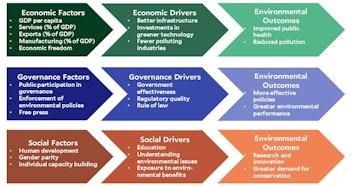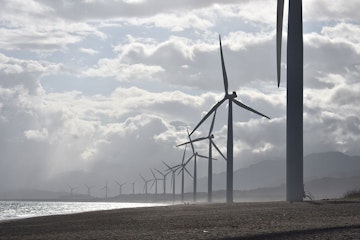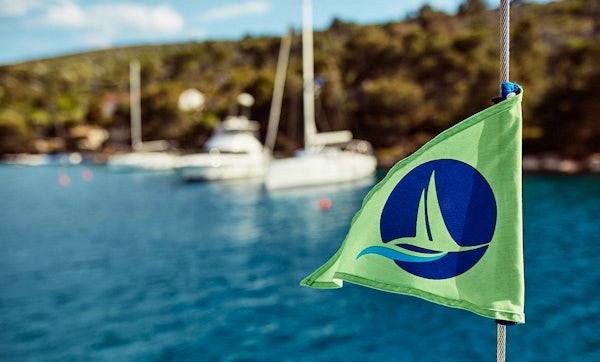Development has historically come at the expense of the environment with countries harnessing the energy of coal, oil, and natural gas combustion to power rapidly growing industries. Globally, environmental policies are trying to mitigate the effects created by this development.
But how effective are these environmental policies? Do they really put us on track for sustainable development or are they just a facade to appease environmental activists?
And if they work, what determines their success? Why are some countries doing much better on an environmental friendliness scale than others?
To answer these questions, scientists at Yale University and Columbia University have developed the “Environmental Performance Index” (EPI), which ranks 180 countries using 40 performance indicators on their national efforts to protect environmental health, enhance ecosystem vitality, and mitigate climate change. In their 2022 report, they also analyze the drivers of good environmental performance in order to inform policy-makers on what they could improve to achieve environmental sustainability.
Collecting data on how well countries perform regarding internationally-set targets for preventing even more environmental damage, and adapting to the consequences of economic progress, is paramount for optimizing the impact of environmental policies. Monitoring the status quo and analyzing what differentiates top-scoring from low-scoring countries is the first step in the long journey towards sustainability.
The indicators used by the EPI can be useful for spotting problems, setting targets, understanding outcomes, and identifying best policy practices. The data and fact-based analysis comprising the EPI can provide a way for government officials to refine their policy agendas, facilitate communications with key stakeholders, and maximize the return on environmental investments.
How does the EPI work?
What are the indicators that are being taken into account?
The indicators used in the analysis are divided into three overarching categories: climate change, environmental health, and ecosystem vitality. Each country is ranked individually for every indicator and receives an overall score. The EPI also provides comparisons between the analyzed countries for each indicator. Their results describe every issue and the frame of reference used for the analysis comprehensively.

The 2022 EPI Framework, illustrating 3 policy objectives, 11 issue categories, and 40 indicators
The ranking system goes from 0 to 100, describing the data from the worst to the best performance through broadly accessible indicators. A maximum score of 100 shows that a country has reached an internationally recognized sustainability target or the expert consensus of good performance. After the assessment of every individual indicator, the EPI weighs and aggregates the scores for each country based on issue category and policy objectives. Because the climate crisis has reached an emergency level and has significant impacts on both environmental and human health, the EPI’s 2022 report has put an enhanced emphasis on countries’ climate performance.
How is the data being collected?
The data comes from trusted sources such as international organizations (including the World Bank and the Potsdam Institute for Climate Impact Research), non-governmental organizations, and academic researchers. Leading sustainability experts validate this data before the EPI research team incorporates them into its analyses.
Limitations
Capturing the full extent of environmental degradation is difficult and it makes it difficult to quantify the impact of sustainability policies as well. The EPI report has shown an increasing amount of indicators over the last decade, encompassing more and more factors in their analyses. However, the EPI only shows the score for the environmental impacts within a country’s boundaries. Since the production of goods is often outsourced, the scores don’t show the total range of environmental impact caused by one country, but rather just the environmental impact within the territorial borders.

There is effort being put into closing this knowledge gap, however at the moment it remains a significant shortcoming. Furthermore, the 2022 EPI report describes that the data available regarding agriculture, freshwater quality, chemical exposure, and ecosystem protection is very restricted leading to significant information gaps.
Drivers of good environmental performance
As mentioned above, the 2022 EPI report also undertakes an analysis of drivers of good environmental performance in order to inform policy makers about changes they could implement to ensure the success of environmental policies.
The report describes three categories that have an effect on the success of environmental policies. These are economic, governance, and social factors, as can be seen in the framework below.

The framework of the 2022 EPI drivers analysis
Economic Factors
Countries with stronger economies have more funds available for investments in environmental protection. They can afford to construct better civil infrastructure (such as drinking water systems and waste water treatment), implement pollution control technologies, and greener energy sources. All this leads to improved public health, which allows them to score high on the environmental performance index.
Nevertheless, after a certain economic threshold, good governance has a stronger influence on environmental performance than wealth. Less wealthier countries sometimes outperform their richer peers thanks to stronger policies and more stringent follow-through. Furthermore, wealthy democracies tend to perform better than wealthy autocracies, suggesting that governance structures join financial resources as an important determinant of sustainability trajectories.
Governance Factors
Good governance can increase the effectiveness of sustainability policies. Reducing corruption and law evasion, supporting public debate reinforced by free press, and encouraging citizens to push their governing authorities for greater environmental protections are all signs of good governance.
By ensuring environmental laws and policies are uniformly enforced and responsive to new information, effective governance drives good environmental performance. Furthermore, having well-funded, adequately staffed civil services that are free from undue political influence contributes to greater public health.

The only policy objective that seems to be less correlated with governance is climate change mitigation. Countries may have climate change mitigation policies in place, however these results suggest they are not stringent enough for what is needed. Drivers of good governance such as public participation in policy-making are not influencing the course of action fast enough. One possible cause for this weak effect might be public misinformation about climate change, which the model fails to take into account.
Social Factors
Societal development leads to a more highly educated, civically engaged, and healthy public. Well-informed and healthy societies better understand critical environmental issues, know firsthand the benefits of regulations, and demand further action from leaders.
Several social factors such as the Human Development Index, social happiness, and well-being are positively correlated with good environmental performance. The Human Development Index refers to the living conditions of people. It is clear from the analysis that human development and environmental health go hand in hand, and the latter can be achieved through the improvement of the former.
Social happiness may influence environmental outcomes for the better by allowing for an identity formation in connection with nature. Environmental performance and well-being are connected according to the EPI results, supporting recent research findings. The extent and significance of this relationship however remains unknown so far.
For a more detailed account of the environmental performance drivers, you can find the full report here.
Where do we stand?
Wealth offers an advantage for the pursuit of sustainability as it enables countries to invest in the necessary infrastructure that improves both human and environmental health. It also allows for investments to be made for technological advancements. However, these measures act first and foremost as a measure of adaptation to the consequences of economic growth. They are merely treating the symptoms, not preventing them.
Technological innovations and a transition to renewable energy might help mitigate future climate change effects, but we cannot rely solely on the hope that we will transition away from fossil fuels soon enough. As the EPI report shows, this is not the case at the moment.

The data suggests that sustainable development – where economic progress and environmental gains occur simultaneously – is possible, although not yet attained by most industrializing countries. Decoupling Gross Domestic Product (GDP) growth from resource use is still a rather idealistic concept. Very few countries are on track to achieving net-zero emissions by 2050 as agreed upon in 2021 through the Glasgow Climate Pact during COP26 (United Nations Climate Change Conference 2021). Amongst them are Denmark and the UK, two of the highest scoring countries on the EPI.
Nonetheless, we have the chance to improve our performance towards the environment through good governance. Brushing up on government effectiveness, the rule of law, and regulatory quality is needed if we are to achieve international set targets for once. This means more robust public debate, officials being held accountable for ineffective policies, and better enforcement of environmental policies amongst other measures.
